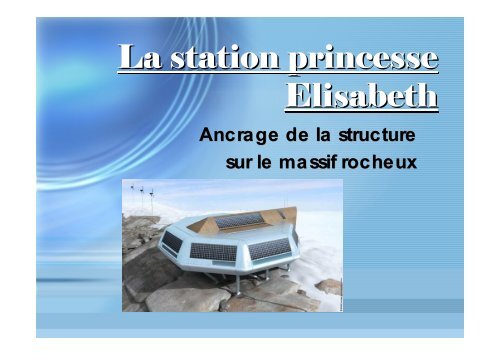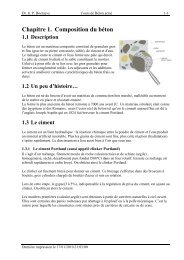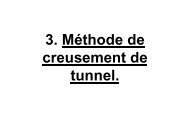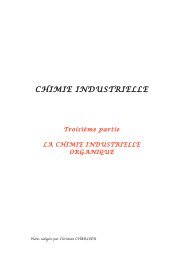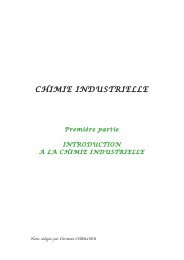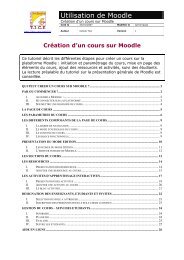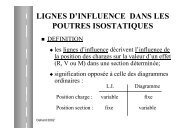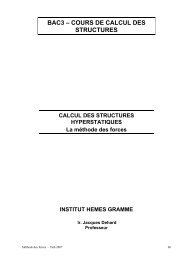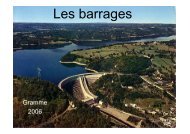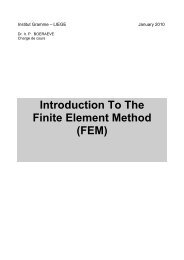Ancrage de la structure sur le massif rocheux Ancrage de la ...
Ancrage de la structure sur le massif rocheux Ancrage de la ...
Ancrage de la structure sur le massif rocheux Ancrage de la ...
Create successful ePaper yourself
Turn your PDF publications into a flip-book with our unique Google optimized e-Paper software.
<strong>Ancrage</strong> <strong>de</strong> <strong>la</strong> <strong>structure</strong><br />
<strong>sur</strong> <strong>le</strong> <strong>massif</strong> <strong>rocheux</strong>
But d un ancrage :<br />
Résister face à <strong>de</strong>s contraintes <strong>de</strong> traction.<br />
Exemp<strong>le</strong>s :<br />
Tirants <strong>de</strong> ponts,<br />
soutènement dans <strong>le</strong>s mines et tunnels,<br />
stabilisations <strong>de</strong> talus,
<strong>Ancrage</strong>s répartis :<br />
La transmission <strong>de</strong>s<br />
efforts s exerce <strong>sur</strong><br />
l ensemb<strong>le</strong> <strong>de</strong> <strong>la</strong> partie<br />
scellée.<br />
Frottement <strong>la</strong>téral entre<br />
<strong>le</strong> sol et <strong>le</strong> scel<strong>le</strong>ment.
<strong>Ancrage</strong>s ponctuels :<br />
La transmission <strong>de</strong>s<br />
efforts s exerce à<br />
l extrémité <strong>de</strong> <strong>la</strong> pièce<br />
ancrée.<br />
Intervention <strong>de</strong> <strong>la</strong> butée<br />
du terrain ainsi<br />
mobilisée.
<strong>Ancrage</strong>s actifs :<br />
<strong>Ancrage</strong>s soumis à une précontrainte.<br />
Sol mobilisé en permanence.<br />
Domaine <strong>de</strong> stabilité mécanique é<strong>la</strong>rgi.<br />
<strong>Ancrage</strong>s passifs :<br />
<strong>Ancrage</strong>s ne mobilisant pas <strong>le</strong> sol tant qu ils ne sont pas<br />
soumis à une force <strong>de</strong> traction ou <strong>de</strong> compression.<br />
Les efforts dans l ancrage varient comme l effort<br />
extérieur.
Vents "catabatiques" (vents d Antarctique pouvant<br />
souff<strong>le</strong>r jusqu'à 320 km/h).<br />
Températures variant <strong>de</strong> -5° à -50°<br />
Utilisation d'ancrages du type passif à scel<strong>le</strong>ment à<br />
l'ai<strong>de</strong> <strong>de</strong> résines exclue.<br />
Type <strong>de</strong> roche :<br />
granite Pigvinane (une roche naturel<strong>le</strong>ment sèche).
Principe :<br />
Expansion d un<br />
système <strong>de</strong> coquil<strong>le</strong>s<br />
<strong>la</strong>téra<strong>le</strong>s dans un forage<br />
préa<strong>la</strong>b<strong>le</strong>ment réalisé.<br />
Le frottement, et donc<br />
<strong>la</strong> résistance à <strong>la</strong><br />
traction, augmentant<br />
avec <strong>le</strong> vissage du<br />
boulon.
Avantages :<br />
Gran<strong>de</strong> facilité <strong>de</strong> mise en<br />
uvre.<br />
Utilisation immédiatement<br />
après <strong>la</strong> pose.<br />
Inconvénients :<br />
Choix diffici<strong>le</strong> du type<br />
d ancrage en fonction du<br />
terrain.<br />
Risque <strong>de</strong> réduction <strong>de</strong> <strong>la</strong><br />
tension dans <strong>le</strong> temps<br />
(évolution du rocher).<br />
Tolérances sévères <strong>sur</strong> <strong>le</strong>s<br />
diamètres <strong>de</strong> forage.
This document was created with Win2PDF avai<strong>la</strong>b<strong>le</strong> at http://www.win2pdf.com.<br />
The unregistered version of Win2PDF is for evaluation or non-commercial use only.<br />
This page will not be ad<strong>de</strong>d after purchasing Win2PDF.


